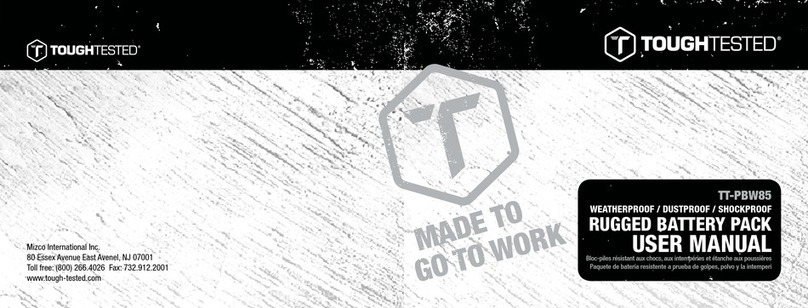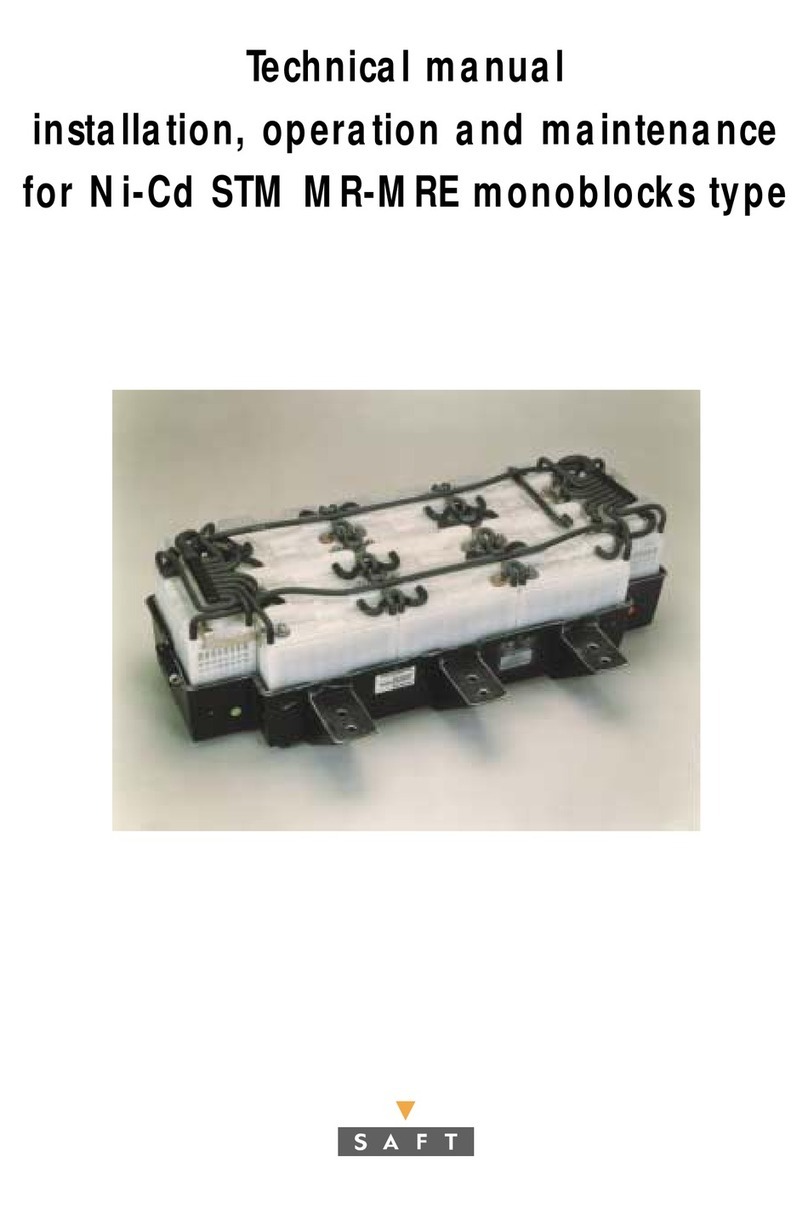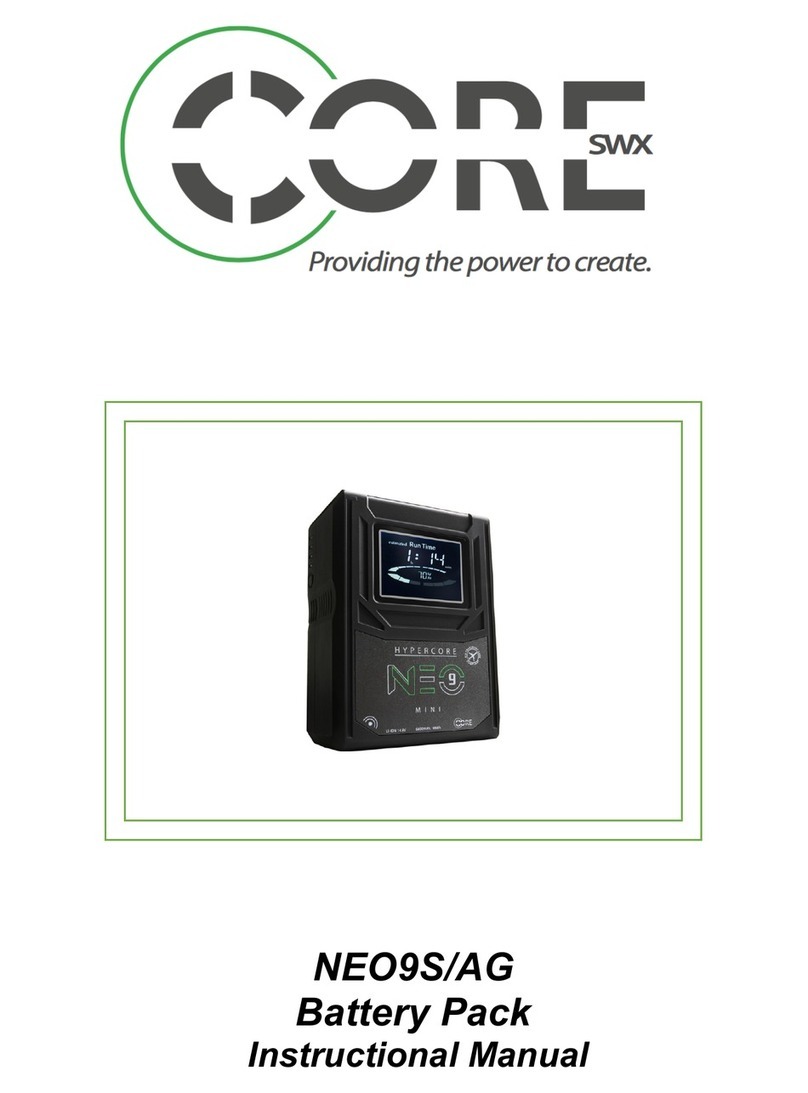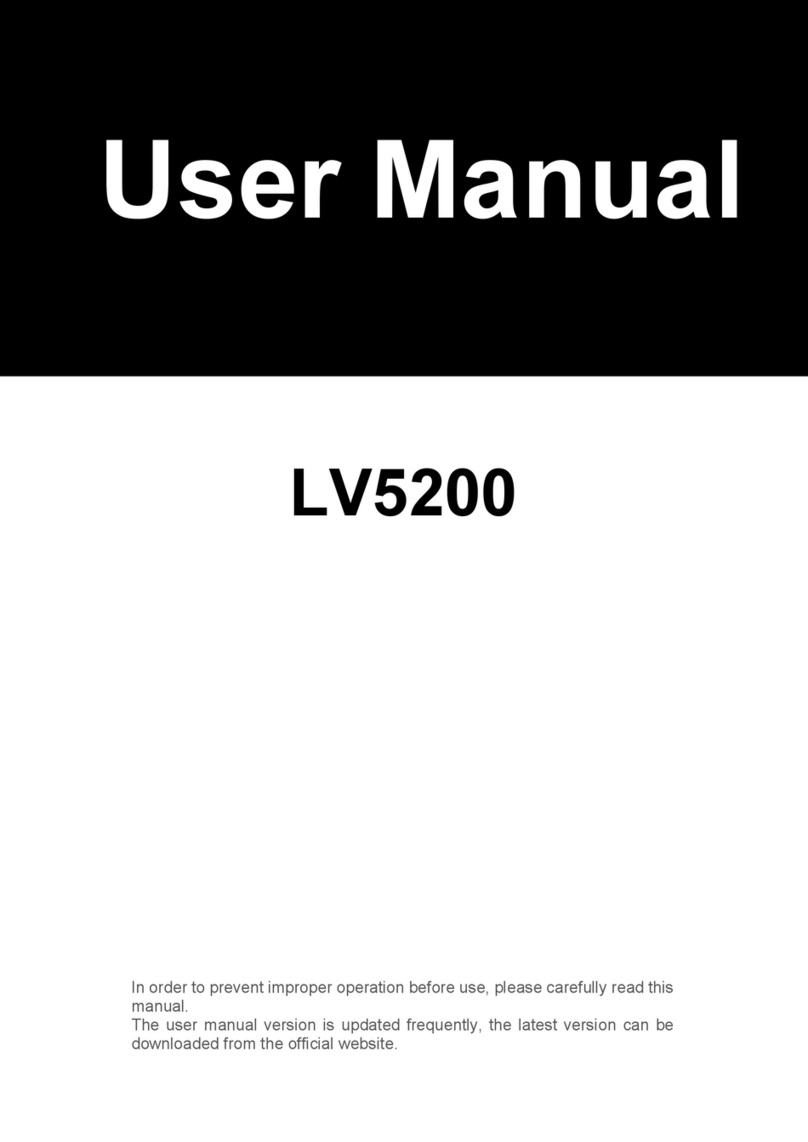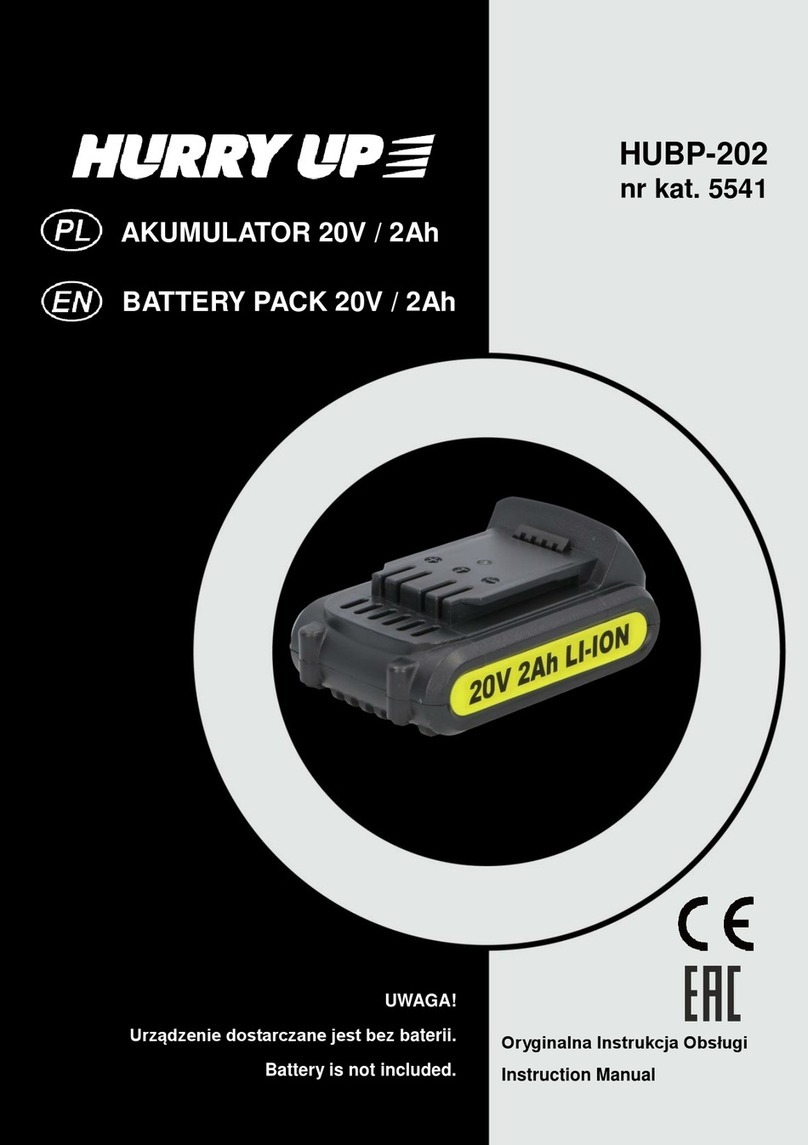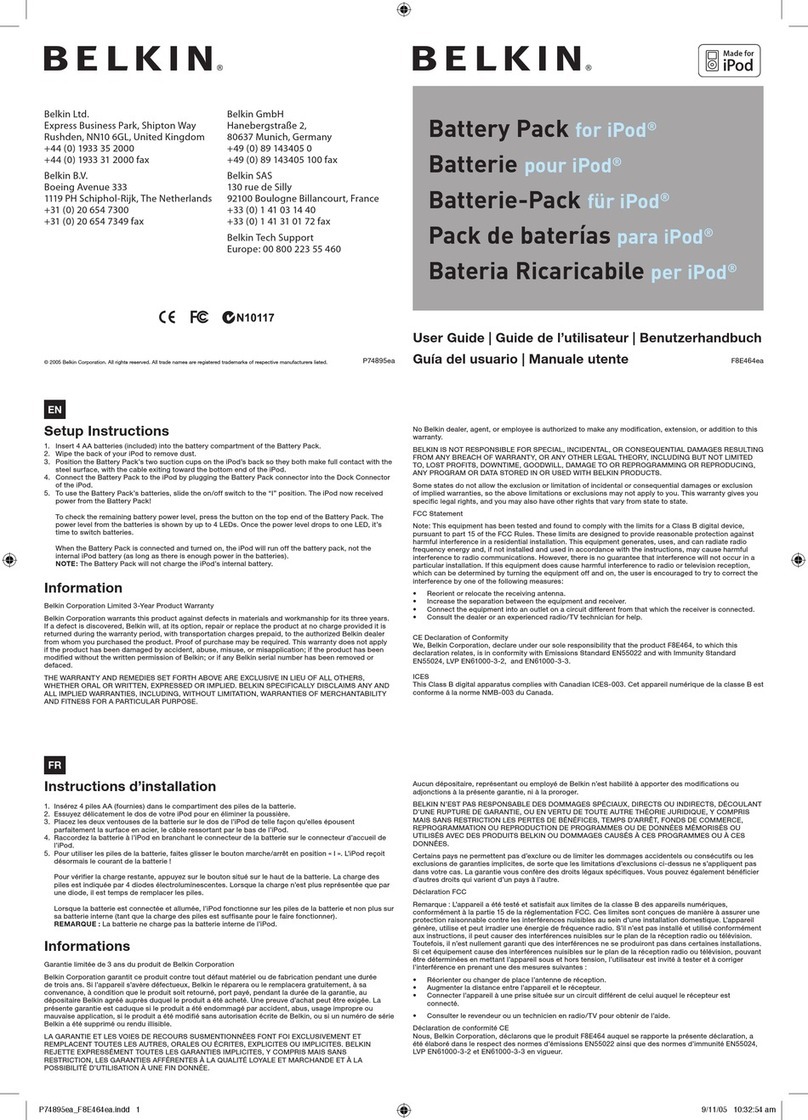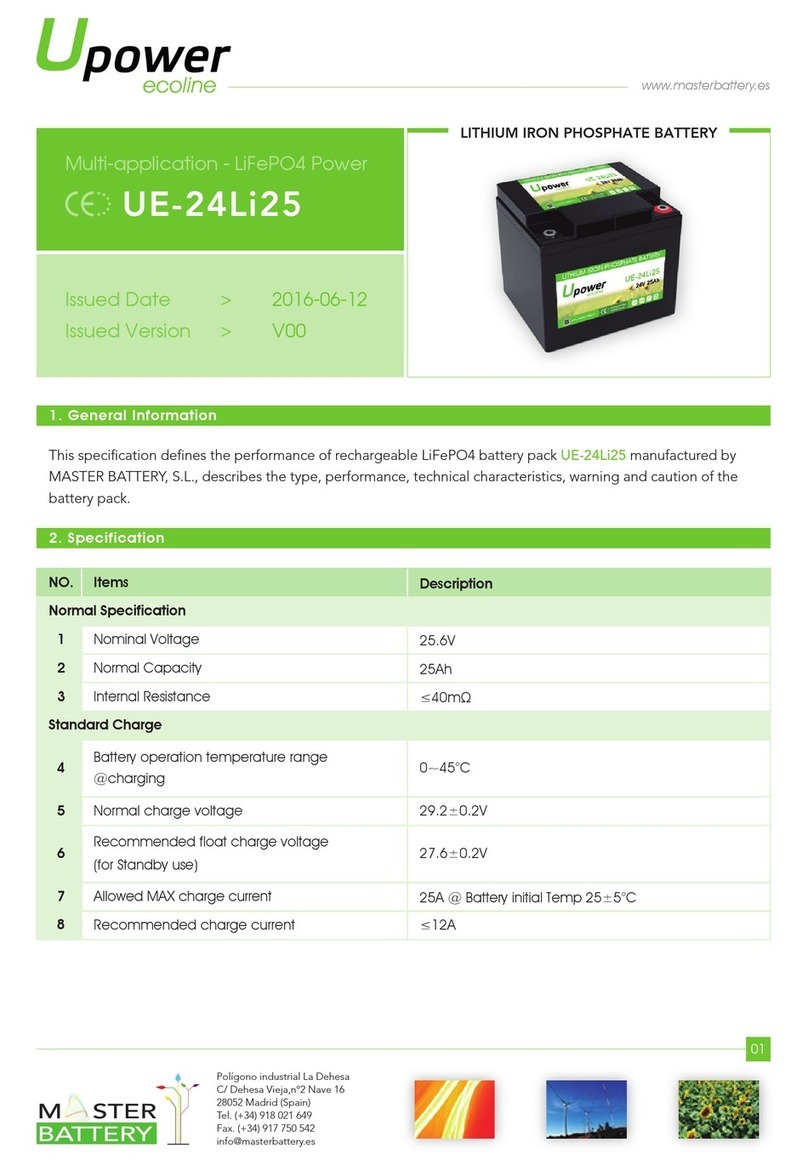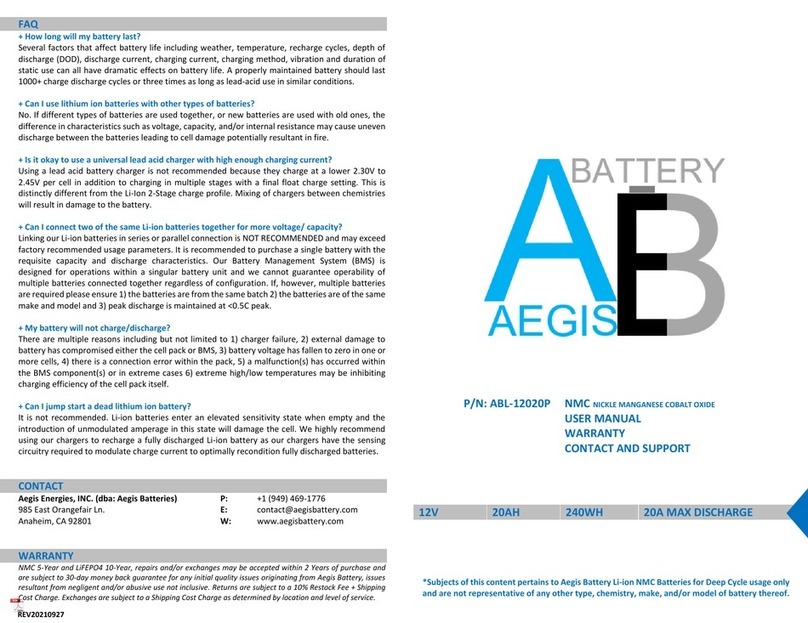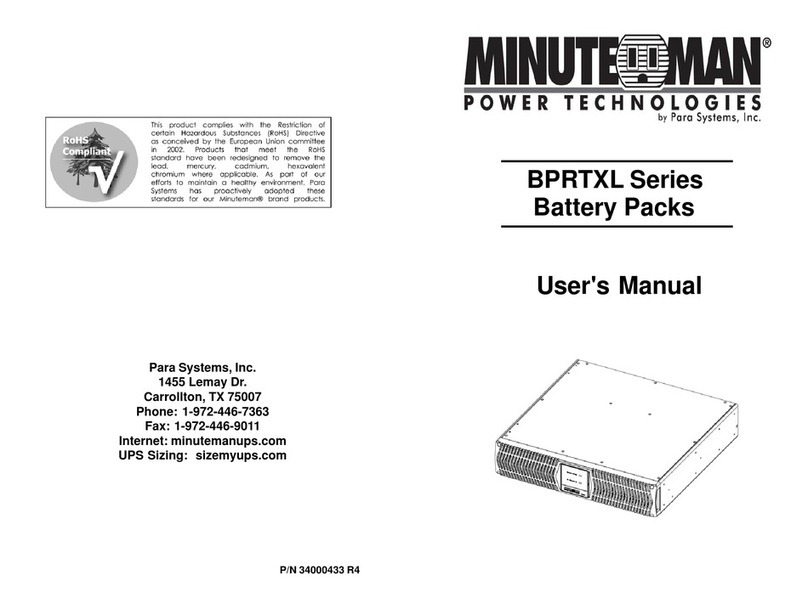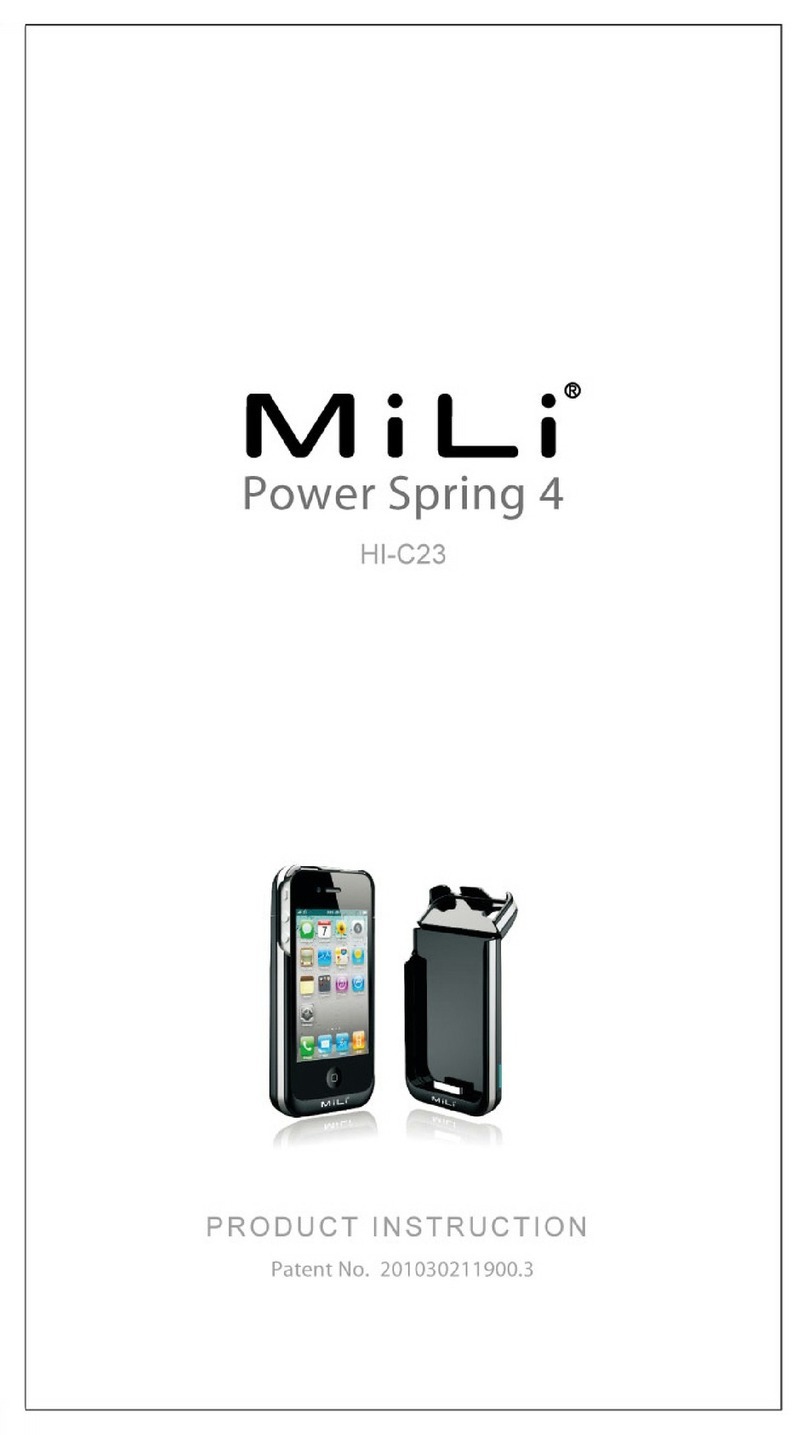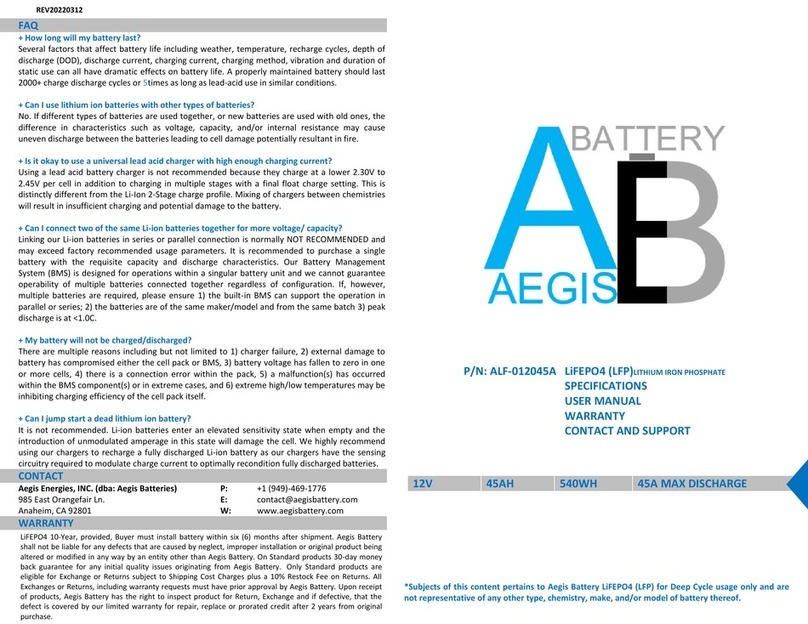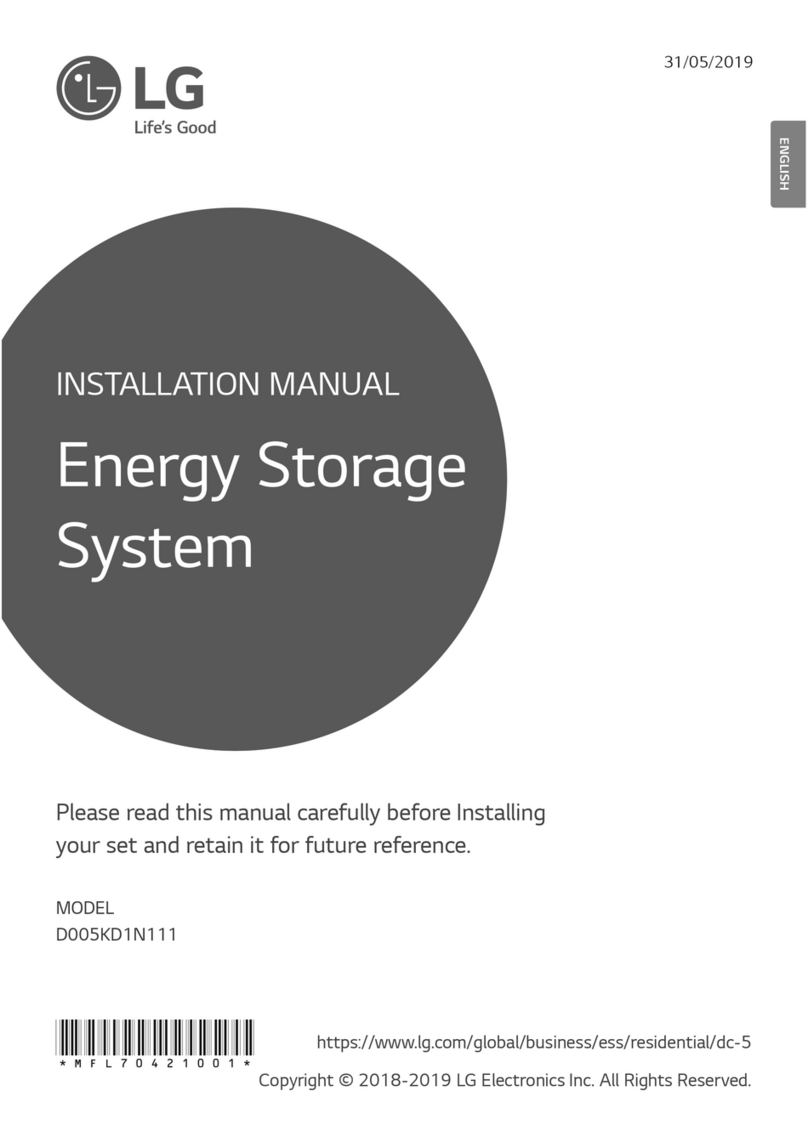Pylontech Force-H2 User manual

Lithium-Ion Phosphate Energy Storage System
Force-H2 Operation Manual
Information Version: 2.2
20P2FH0301
Lithium-Ion Phosphate Energy Storage System


This manual introduces Force-H2 from Pylontech. Force-H2 is a high voltage Lithium-Ion
Phosphate Battery storage system. Please read this manual before you install the battery and
follow the instruction carefully during the installation process. Any confusion, please contact
Pylontech immediately for advice and clarification.
Content
1. SAFETY.......................................................................................................................................................................1
1.1 Symbol..................................................................................................................................................... 1
Symbol in label................................................................................................................................................ 1
1.2 Before Connecting..................................................................................................................................4
1.3 In Using........................................................................................................................................................ 4
2. SYSTEM INTRODUCE...............................................................................................................................................5
2.1 Product Introduce................................................................................................................................ 5
2.2 Specifications.........................................................................................................................................5
2.2.1 The parameter of system................................................................................................................ 6
2.2.2 Battery Module (FH48074)..................................................................................................................7
2.2.3 Control Module FC0500M-40 (internal power supply)...............................................................8
LED Indicators Instructions............................................................................................................................9
Definition of RJ45 Port Pin...........................................................................................................................12
2.3 System Diagram.................................................................................................................................. 12
3. INSTALLATION....................................................................................................................................................... 13
3.1 Tools........................................................................................................................................................ 13
3.2 Safety Gear.......................................................................................................................................... 13
3.3 System Working Environments Checking.....................................................................................14
3.3.1 Cleaning............................................................................................................................................ 14
3.3.2 Temperature..................................................................................................................................... 14
3.3.3 Fire-extinguisher System.................................................................................................................14
3.3.4 Grounding System...........................................................................................................................14
3.4 Handling and placement................................................................................................................ 14
3.4.1 Handling and placement of the battery module................................................................. 14
3.4.2 Handling and placement of the base......................................................................................14
3.4.3 Selection of installation sites.........................................................................................................14
3.4.4 Mounting and installation of the base......................................................................................15
3.4.5 Battery Modules and Control Module (BMS) pile up............................................................ 16
3.4.6 Installation of the metal bracket for the system.....................................................................17
3.4.7 Locking of the control Module’s fix screw of left and right side........................................ 19
3.5 Cables connection............................................................................................................................ 19
3.5.2 Cables................................................................................................................................................ 21
3.5.3 System turns on................................................................................................................................ 22
3.5.4 System turns off................................................................................................................................ 24

4. SYSTEM DEBUG..................................................................................................................................................... 25
5. MAINTENANCE..................................................................................................................................................... 26
5.1 Trouble Shooting:................................................................................................................................ 26
5.2 Replacement of main component...............................................................................................28
5.2.1 Replacement of Battery Module................................................................................................28
5.2.2 Replacement of Control Module (BMS)................................................................................... 30
5.3 Battery Maintenance........................................................................................................................ 30
6. STORAGE RECOMMENDATIONS.......................................................................................................................32
7. SHIPMENT............................................................................................................................................................... 32
ANNEX 1: INSTALLATION AND SYSTEM TURN ON PROGRESS LIST.................................................................33
ANNEX 2: SYSTEM TURN OFF PROGRESS LIST..................................................................................................... 34

1/34
1. Safety
The Force-H2 is a high voltage DC system, operated by skilled/qualified personnel only. Read all
safety instructions carefully prior to any work and observe them at all times when working on with
the system.
Incorrect operation or work may cause:
injury or death to the operator or a third party;
damage to the system hardware and other properties belonging to the operator or a third
party.
Skills of Qualified Personnel
Qualified personnel must have the following skills:
training in the installation and commissioning of the electrical system, as well as the dealing
with hazards;
knowledge of this manual and other related documents;
knowledge of the local regulations and directives.
1.1 Symbol
Danger
Lethal voltage!
Battery strings will produce HIGH DC power and can cause a
lethal voltage and an electric shock.
Only qualified person can perform the wiring of the battery
strings.
Warning
Risk of battery system damage or personal injury
DO not pull out the connectors while the system is working!
De-energize from all multiple power sources and verify that
there is no voltage.
Caution
Risk of battery system failure or life cycle reduces.
Symbol
in label
Read the product and operation manual before operating the
battery system!

2/34
Symbol
in label
Danger! Safety!
Symbol
in label
Warning electric shock!
Symbol
in label
Do not place near flammable material
Symbol
in label
Do not reverse connection the positive and negative.
Symbol
in label
Do not place near open flame
Symbol
in label
Do not place at the children and pet touchable area.
Symbol
in label
Recycle label.
Symbol
in label
Label for Waste Electrical and Electronic Equipment (WEEE)
Directive (2012/19/EU)

3/34
Symbol
in label
The certificate label for EMC.
Symbol
in label
The certificate label for Safety by TÜV SÜD.
Symbol
in label
The certificate label for Safety by TÜV Rheinland.
Symbol
in label
The certificate label for Safety by TÜV Rheinland.
Danger: Batteries deliver electric power, resulting in burns or a fire hazard when they are short
circuited, or wrongly installed.
Danger: Lethal voltages are present in the battery terminals and cables. Severe injuries or death
may occur if touch the cables and terminals.
Warning: DO NOT open or deform the battery module, otherwise the product will be out of
warranty scope
Warning: Whenever working on the battery, wear suitable personal protective equipment (PPE)
such as rubber gloves, rubber boots and goggles.
Warning: Force-H2 system working temperature range: 0℃~50℃; Optimum temperature: 18℃~
28℃. Out of the working temperature range may cause the battery system over / low
temperature alarm or protection which further lead to the cycle life reduction as well as.
It will affect the warranty terms as well.
Warning: For battery installation, the installer shall refer to NFPA70 or similar local installation
standard for operation.
Caution: Improper settings or maintenance can permanently damage the battery.
Caution: Incorrect inverter parameters will lead to a further faulty/damage to battery.

4/34
Reminding
1) It is very important and necessary to read the user manual carefully (in the accessories)
before installing or using battery. Failure to do so or to follow any of the instructions or
warnings in this document can result in electrical shock, serious injury, or death, or can
damage battery, potentially rendering it inoperable.
2) If the battery is stored for long time, it is required to charge them every six months, and the
SOC should be no less than 90%;
3) Battery needs to be recharged within 12 hours, after fully discharged;
4) Do not expose cable outside;
1.2 Before Connecting
1) After unpacking, please check product and packing list first, if product is damaged or
lack of parts, please contact with the local retailer;
2) Before installation, be sure to cut off the grid power and make sure the battery is in the
switched-off mode;
3) Wiring must be correct, do not mistake the positive and negative cables, and ensure no
short circuit with the external device;
4) It is prohibited to connect the battery and AC power directly;
5) Battery system must be well ground and the resistance must be less than 100mΩ;
6) Please ensured the electrical parameters of battery system are compatible to related
equipment;
7) Keep the battery away from water and fire.
1.3 In Using
1) If the battery system needs to be moved or repaired, the power must be cut off and the
battery is completely shut down;
2) It is prohibited to connect the battery with different type of battery.
3) It is prohibited to put the batteries working with faulty or incompatible inverter;
4) It is prohibited to disassemble the battery (QC tab removed or damaged);
5) In case of fire, only dry powder fire extinguisher can be used, liquid fire extinguishers are
prohibited;

5/34
2. System Introduce
2.1 Product Introduce
Force-H2 is a high voltage battery storage system based on lithium iron phosphate battery, which
is one of the new energy storage products developed and produced by Pylontech. It can be
used to support reliable power for various types of equipment and systems. Force-H2 is especially
suitable for those application scenes which required high power output, limited installation space,
restricted load-bearing and long cycle life.
2.2 Specifications

6/34
2.2.1 The parameter of system
Product Type
Force-H2
Cell Technology
Li-iron (LFP)
Battery System Capacity(kWh)
7.10
10.65
14.20
Battery System Voltage(Vdc)
192
288
384
Battery System Capacity(AH)
37Ah
Battery Controller Name
FC0500M-40S
Battery Module Name
FH9637M
Battery Module Quantity(pcs)
2
3
4
Battery Module Capacity(kWh)
3.552
Battery Module Voltage(Vdc)
96
Battery Module Capacity(AH)
37
Battery System Charge Upper-Voltage(Vdc)
174
261
348
Battery System Charge Current(Amps, Standard)
7.4
Battery System Charge Current(Amps, Normal)
18.5
Battery System Charge Current(Amps, Max.@15s)
40
Battery System Discharge lower-Voltage(Vdc)
216
324
432
Battery System Discharge Current(Amps, Standard)
7.4
Battery System Discharge Current(Amps, Normal)
18.5
Battery System Discharge Current(Amps, Max.@15s)
40
Short circuit rating(Amps)
<4000
Efficiency(%)
96
Depth of Discharge(%)
90
Dimension(W*D*H, mm)
450*296*822
450*296*1118
450*296*1414
Communication
CANBUS/Modbus RTU
Protection Class
IP55
Weight(kg)
82
117
152
Operation Life(Years)
15+
Operation Temperature(℃)
0~50℃
Storage Temperature(℃)
-20~60℃
Humidity
5~95%
Product Certificate
VDE2510-50, IEC62619, IEC62477-1,
IEC62040-1, CEC, CE
Transfer Certificate
UN38.3
1)Battery Controller Dimensions(W*D*H)
2)Battery Module Dimensions (W*D*H)
3)Battery bottom base Dimensions(W*D*H)
450×296×190 mm
450×296×296mm
450×296×40 mm

7/34
2.2.2 Battery Module (FH48074)
Product Type
FH9637M
Cell Technology
Li-ion (LFP)
Battery Module Capacity (kWh)
3.552
Battery Module Voltage (Vdc)
96
Battery Module Capacity (Ah)
37
Battery Module Serial Cell Quantity (pcs)
30
Battery Cell Voltage (Vdc)
3.2
Battery Cell Capacity (AH)
37
Dimension (W*D*H, mm)
450*296*296
Weight (kg)
35
Operation Life
15+Years
Operation Cycle Life
5,000
Operation Temperature
0~50℃
Storage Temperature
-20~60℃
Transfer Certificate
UN38.3

8/34
2.2.3 Control Module FC0500M-40 (internal power supply)
Control Module (FC0500-40) Display Panel
LED Button
Short Press
Display the LED panel for 20sec.
Long Press
(more than
5sec)
When status LED fast flashes blue ●, loss the button, then it is
115200 baud rate of RS485.
When status LED fast flashes orange ●, loss the button, then it
is 9600 baud rate of RS485.
Status
2 colors, Blue and orange
Refer to [LED Indicators Instructions]

9/34
Battery Module Status
Blue solid
Normal
Orange solid
Individual module alarm or
protection. See trouble shooting
steps in section 5.1
System Capacity
System SOC
Each LED indicate 25%SOC
Indicate the system SOC.
LED Indicators Instructions
Condition
Note
Self-checking
Blue, Flashing
All flashing
Self-checking
failure
Orange, Slow
flashing
Off
Battery Module
Status off. See
trouble shooting
steps in section
5.1
Black start success
Blue, fast flashing
Off
Black start failure
Orange, Fast
flashing
Off
See trouble
shooting steps in
section 5.1
Communication
Lost or BMS error
Orange, solid
Indicate SOC, blue, solid
See trouble
shooting steps in
section 5.1
Idle
Blue, slow flashing
Indicate SOC, blue, solid
Charge
Blue, solid
Indicate SOC, blue, solid
Floating charge
Blue, solid
All flashing, horse race lamp
Discharge
Blue, flashing
Indicate SOC, blue, solid
System sleep
Blue, flashing
Off
Battery module
status off

10/34
Remark: Slow flashing: 2.0s ON/1.0s OFF. Flashing 0.5s ON/0.5s OFF.
Fast flashing: 0.1s ON/0.1s OFF.
Control Module (FC0500M-40S) Cable Panel
Power Switch
ON: main breaker ON, able to turn on battery system by start button.
OFF: system turn off completely, no power output.
Caution: When the breaker is tripped off because of over current or short circuit, must wait
more than 30min then can turn on it again, otherwise may cause the breaker damage.
Start
Start function: press more than 5sec until the
buzzer rings, to turn on controller.
Black start function: when system turn on, and relay is OFF, press more than 10sec, and relay will
turn on for 10 min without communication(depends on conditions).
WiFi
Manufacturer: Pylon Technologies Co., Ltd.

11/34
Address: Plant 8, No.505 Kunkai Road, JinXi Town, 215324 Kunshan City, Jiangsu Province,
PEOPLE'S REPUBLIC OF CHINA
Importer: XXXX (Located in installed country)
Address: XXXX (Located in installed country)
Wireless maximum output power: 20dBm
Operating frequency: 2412-2472MHz
Gain of antenna: Max 3dBi
Modulation system:
DBPSK/DQPSK/CCK(DSSS)
BPSK/QPSK/16QAM/64QAM(OFDM)
Modulating Repetition:
1Mbps/2Mbps/5.5Mbps/11Mbps(DSSS)
6Mbps/9 Mbps/12 Mbps/18 Mbps/24 Mbps/36 Mbps/48 Mbps/54 Mbps(OFDM)
MCS0~MCS7(802.1 1n 20MHz)
Channel spacing:5MHZ
Type of antenna: 2.4G IPEX-SMA Antenna
Power Terminal (+/-)
Connect power cables of battery system with Inverter.
Communication Terminal (RS485 / CAN / RS232)
RS485 Communication Terminal: (RJ45 port) follow MODBUS 485 protocol, for communication
between battery system and inverter.
CAN Communication Terminal: (RJ45 port) follow CAN protocol, for communication between
battery system and inverter.
RS232 Communication Terminal: (RJ45 port) for manufacturer or professional engineer to
debug or service.

12/34
Definition of RJ45 Port Pin
No.
CAN
RS485
RS232
1
---
---
---
2
GND
---
---
3
---
---
TX
4
CANH
---
---
5
CANL
---
---
6
---
---
RX
7
---
RS485A
---
8
---
RS485B
---
2.3 System Diagram

13/34
3. Installation
3.1 Tools
The following tools are required to install the battery pack:
Wire Cutter
Crimping Modular Plier
Cable Ties
Screw Driver Set
Electric Screw Driver
Adjustable Wrench
Sleeve Piece
600VDC Multimeter
NOTE
Use properly insulated tools to prevent accidental electric shock or short circuits.
If insulated tools are not available, cover the entire exposed metal surfaces with available
insulated alternatives, except their tips, with electrical tape.
3.2 Safety Gear
It is recommended to wear the following safety gear when dealing with the battery pack
Insulated gloves Safety goggles Safety shoes

14/34
3.3 System Working Environments Checking
3.3.1 Cleaning
Before installation and system power on, the dust and iron scurf must be removed to keep a
clean environment.
The system cannot be installed in desert area without an enclosure to prevent from sand.
Danger: Battery module has active DC power at terminal all the time), must be careful to handle
the modules.
3.3.2 Temperature
Force-H2 system working temperature range: 0℃~50℃; Optimum temperature: 18℃~28℃.
Caution: Force-H2 system is IP55 design. But please avoid frost or direct sunlight. Out of the
working temperature range will cause the battery system over / low temperature alarm or
protection which further lead to the cycle life reduction. According to the environment, the
cooling system or heating system should be installed if it is necessary.
3.3.3 Fire-extinguisher System
It must be equipped with fire-extinguisher system for safety purpose.
The fire system needs to be regularly checked to be in normal condition. Refer to the using and
maintenance requirements please follow local fire equipment guidance.
3.3.4 Grounding System
Before the battery installation must make sure the grounding point of the basement is stable and
reliable. If the battery system is installed in an independent equipment cabin (e.g. container),
must make sure the grounding of the cabin is stable and reliable.
The resistance of the grounding system must ≤100mΩ
3.4 Handling and placement
Warning: The battery pile’s power terminals are high voltage DC. It must be installed in a
restricted access area;
Warning: Force-H2 is a high voltage DC system, operated by qualified and authorized personnel
only.
3.4.1 Handling and placement of the battery module
Single battery module is 36kg. If without handling tools must have more than 2 men to handling
with it.
3.4.2 Handling and placement of the base
The base is light, single person can handle with it.
3.4.3 Selection of installation sites
A. Force-H2 system working temperature range: 0℃~50℃; Optimum temperature: 18℃~28℃.

15/34
Do not place the battery system in direct sun light. It is suggested to build sunshade
equipment. In cold area the heating system is required.
B. Force-H2 system must not be immersed in water. Can not be placed the battery base in rain
or other water sources. As a suggestion, the base’s height should >300mm above the ground.
C. The base’s weight capacity should support the weight of whole battery system (130~300kg).
3.4.4 Mounting and installation of the base
The base must be fixed installed on the basement with 4pcs M8×80 foundation bolts.
Battery rack basement holes bitmap (unit: mm):

16/34
3.4.5 Battery Modules and Control Module (BMS) pile up
Handle above the red marked edgings of the both side of these battery modules and control
module (BMS).
Caution: If hands under this red marked side, hands will get hurt.
Table of contents
Other Pylontech Batteries Pack manuals
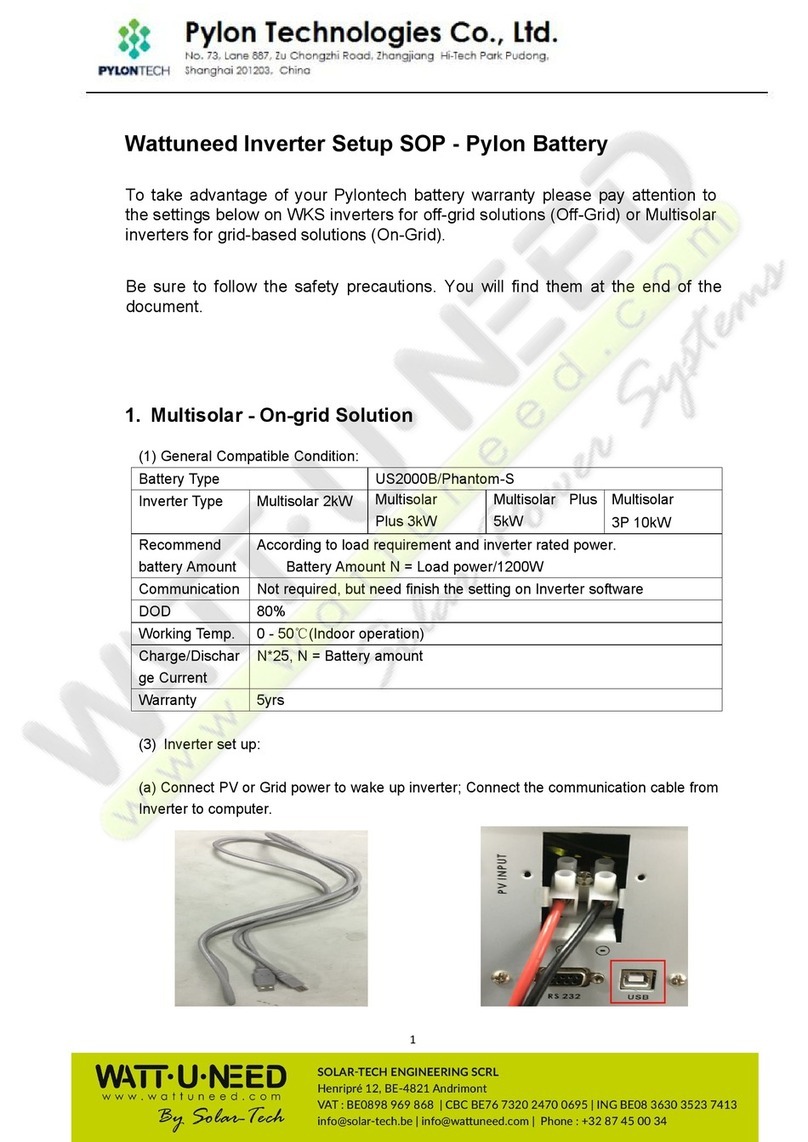
Pylontech
Pylontech Phantom-S User manual
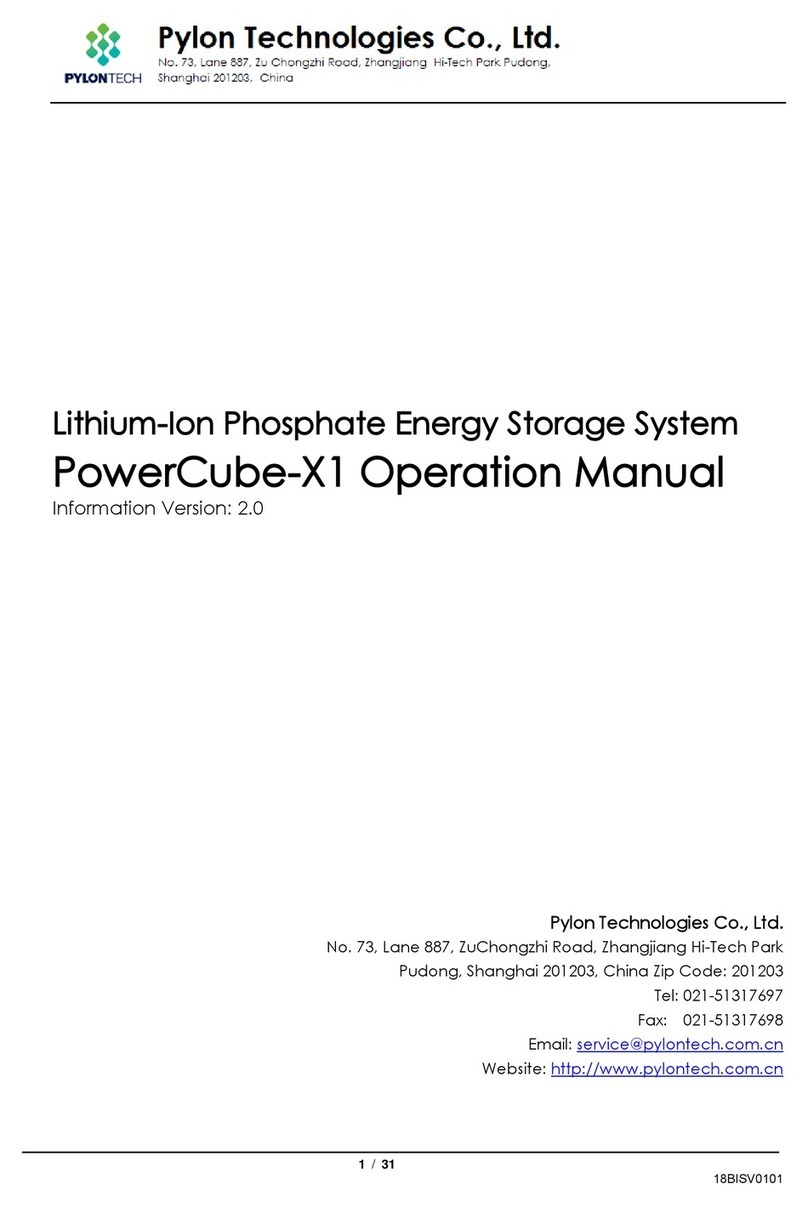
Pylontech
Pylontech PowerCube-X1 User manual
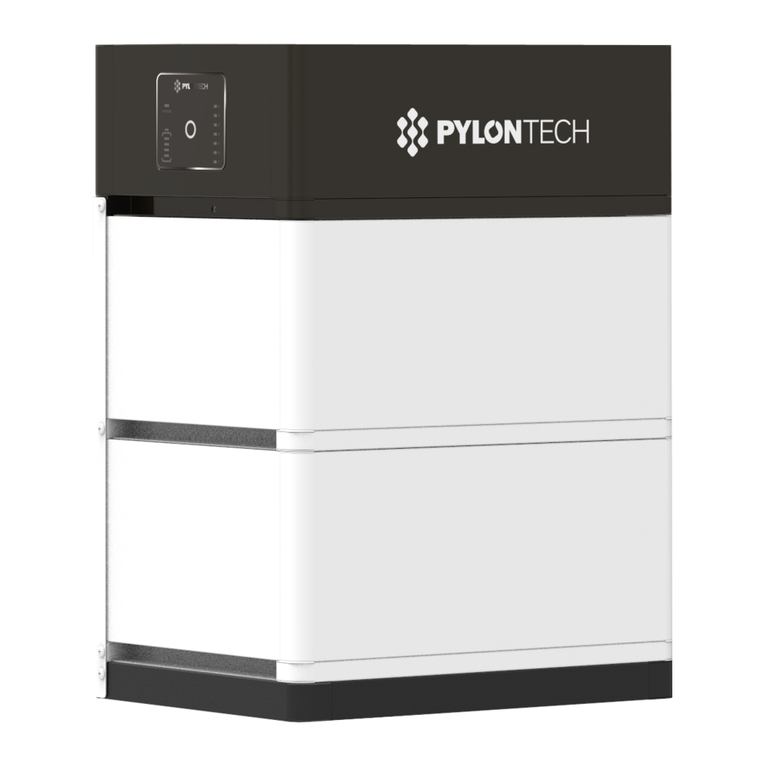
Pylontech
Pylontech Force-L2 User manual
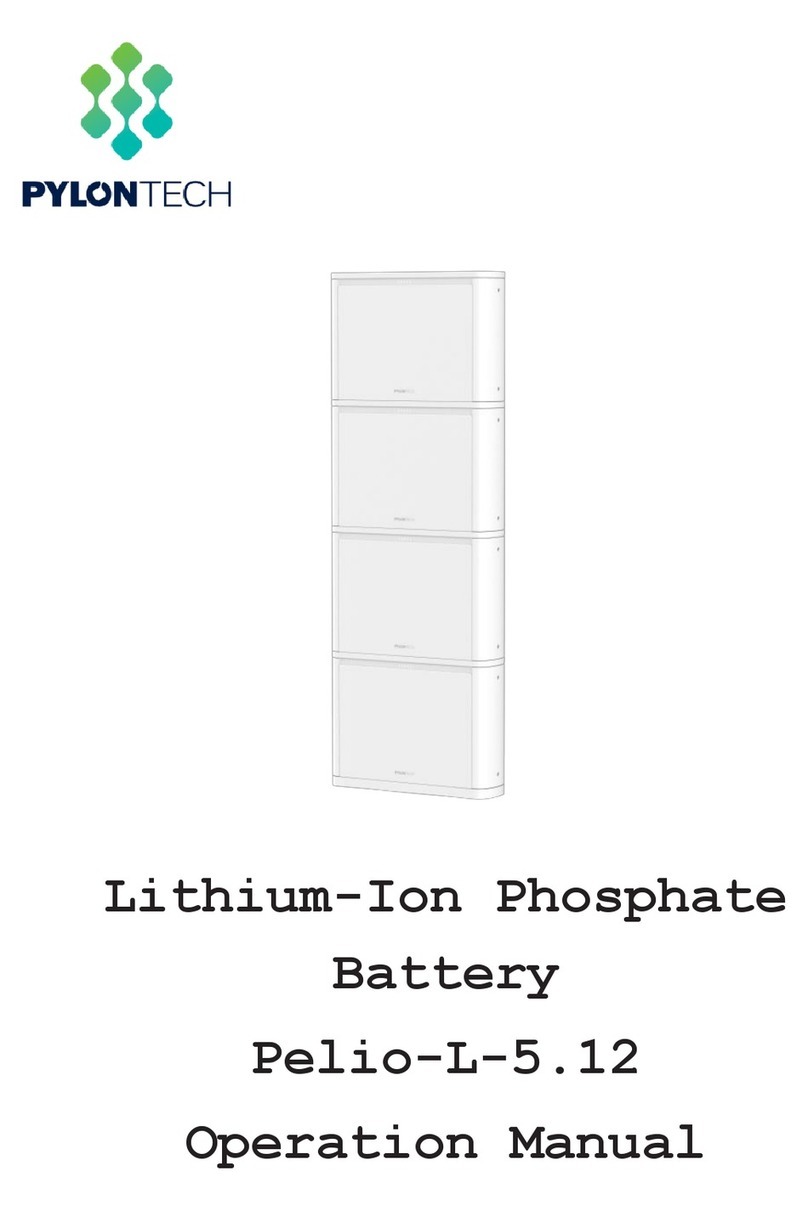
Pylontech
Pylontech Pelio-L-5.12 User manual
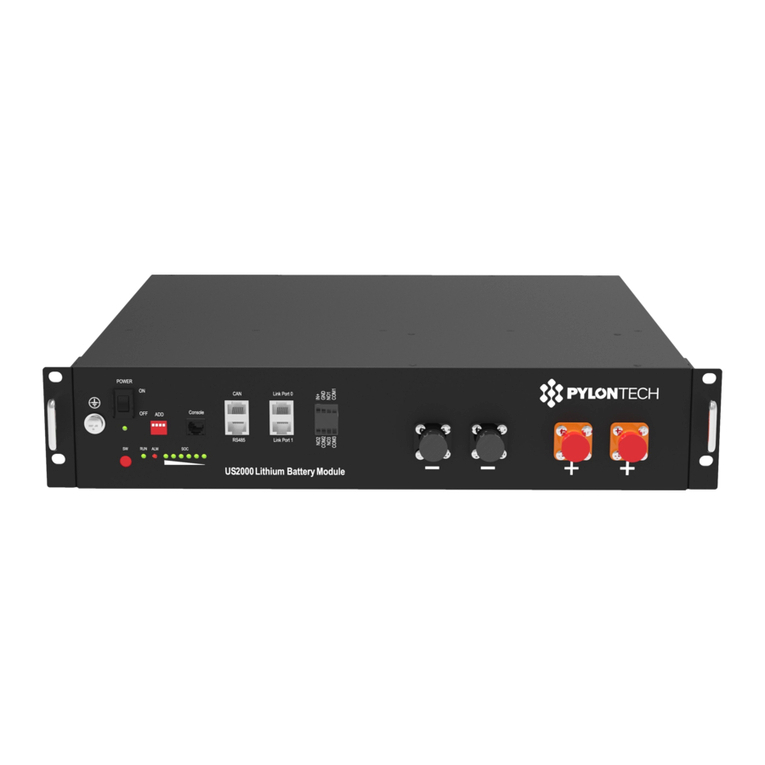
Pylontech
Pylontech US2000 User manual
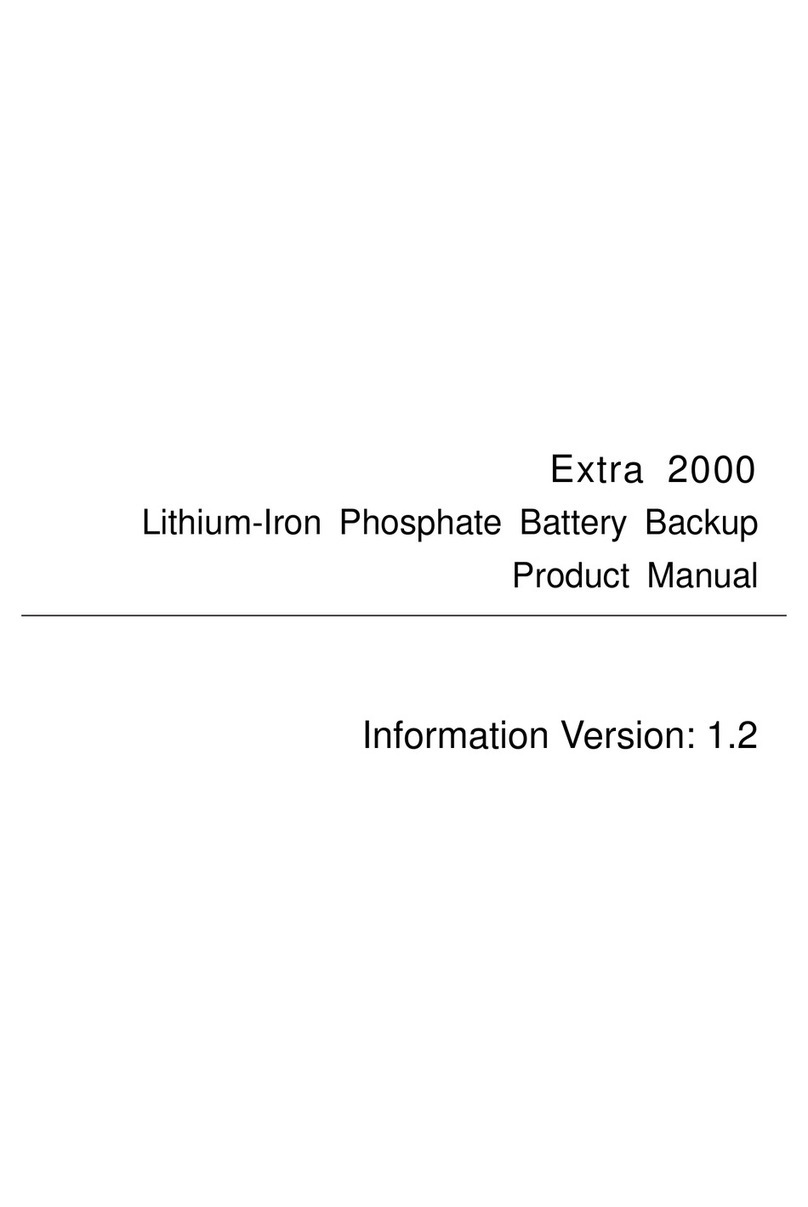
Pylontech
Pylontech Extra 2000 User manual
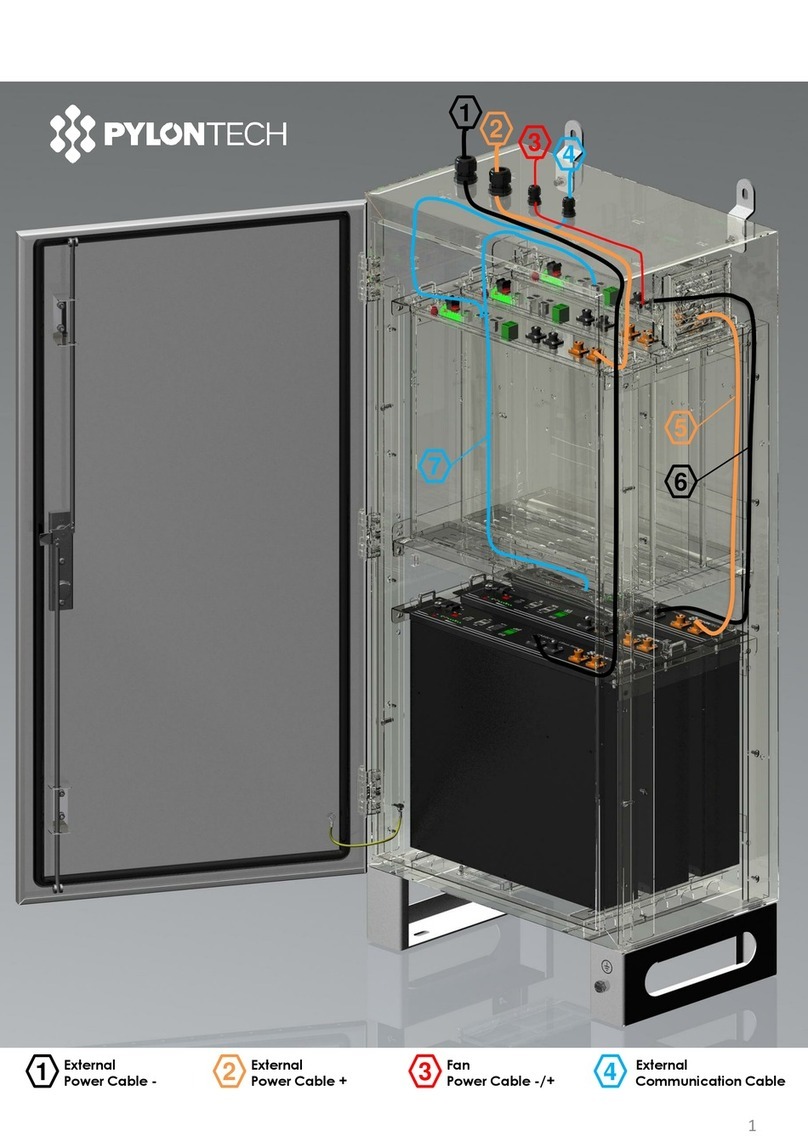
Pylontech
Pylontech US2000 PLUS User manual

Pylontech
Pylontech FORCE H Series User manual
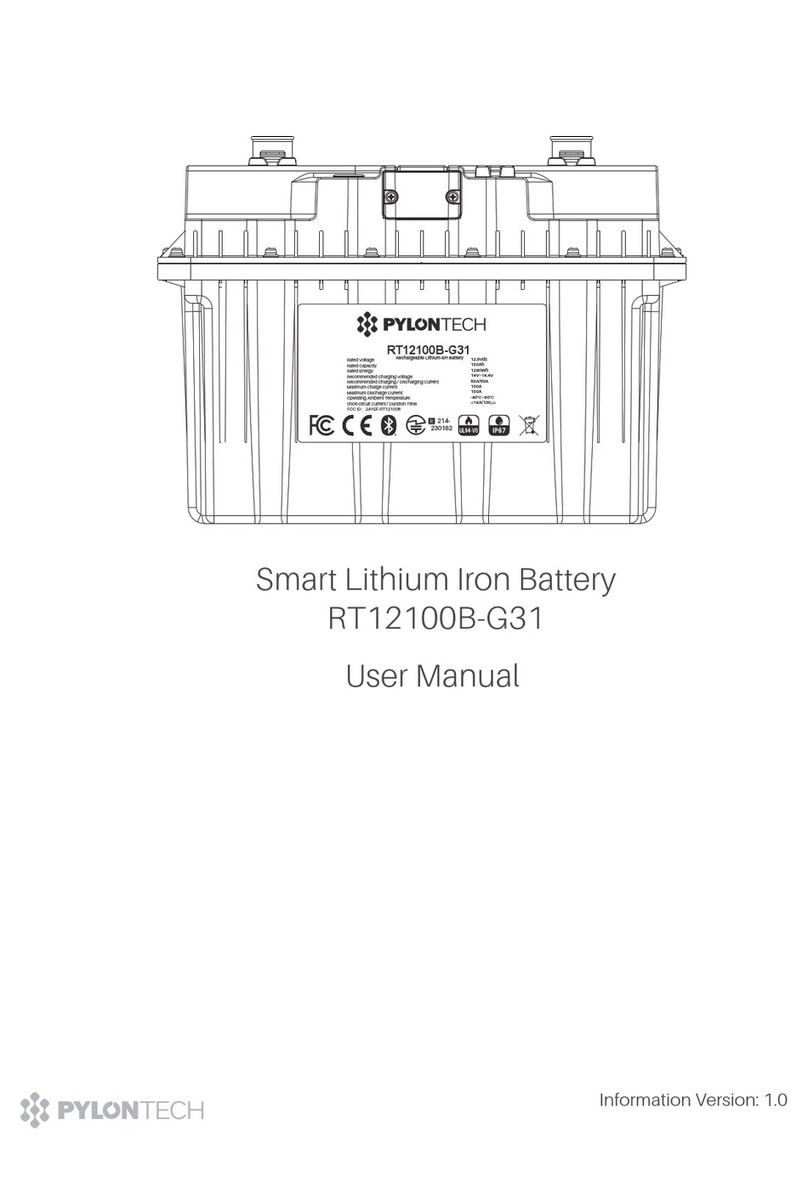
Pylontech
Pylontech RT12100B-G31 User manual
